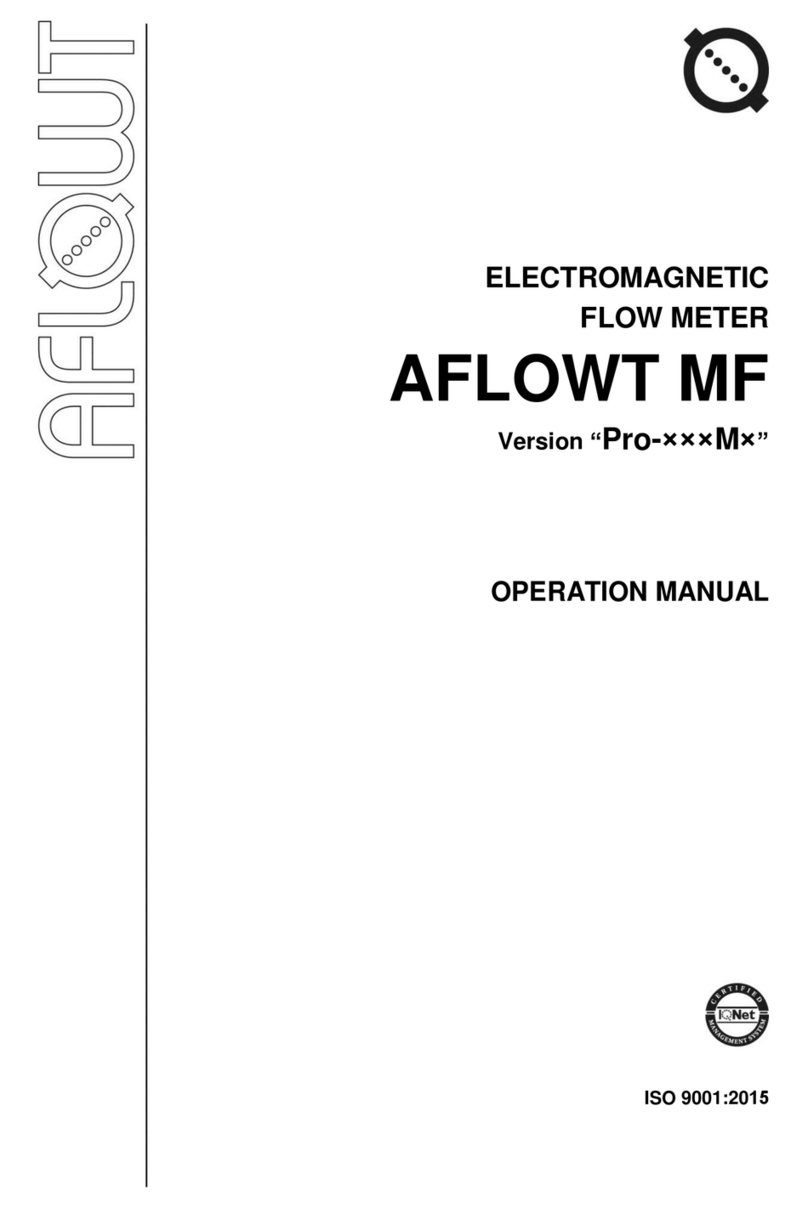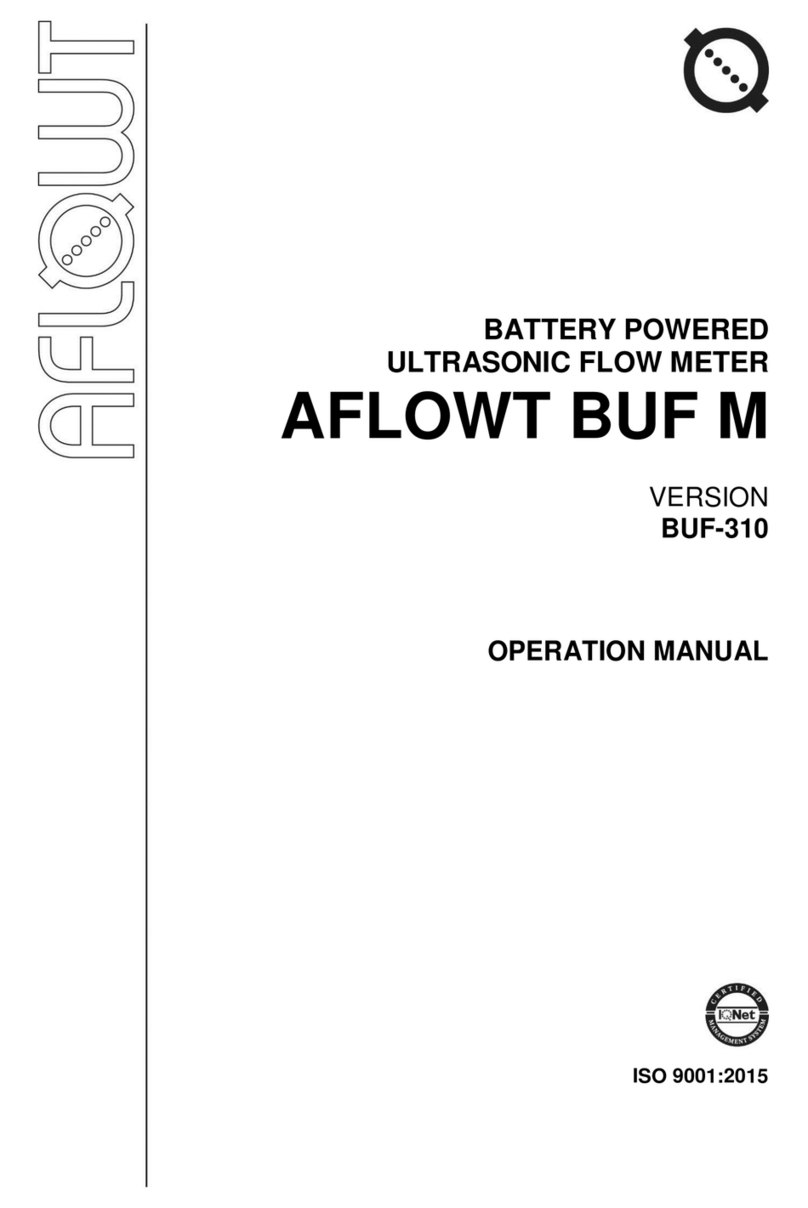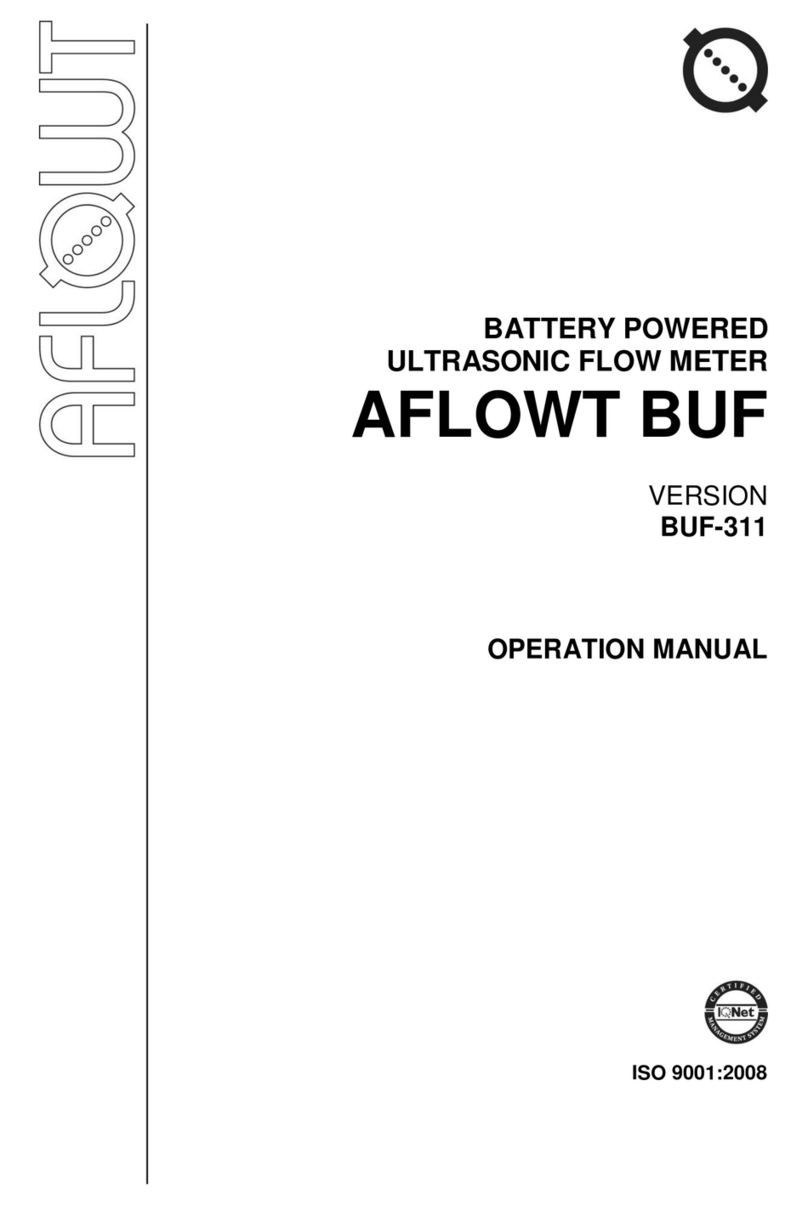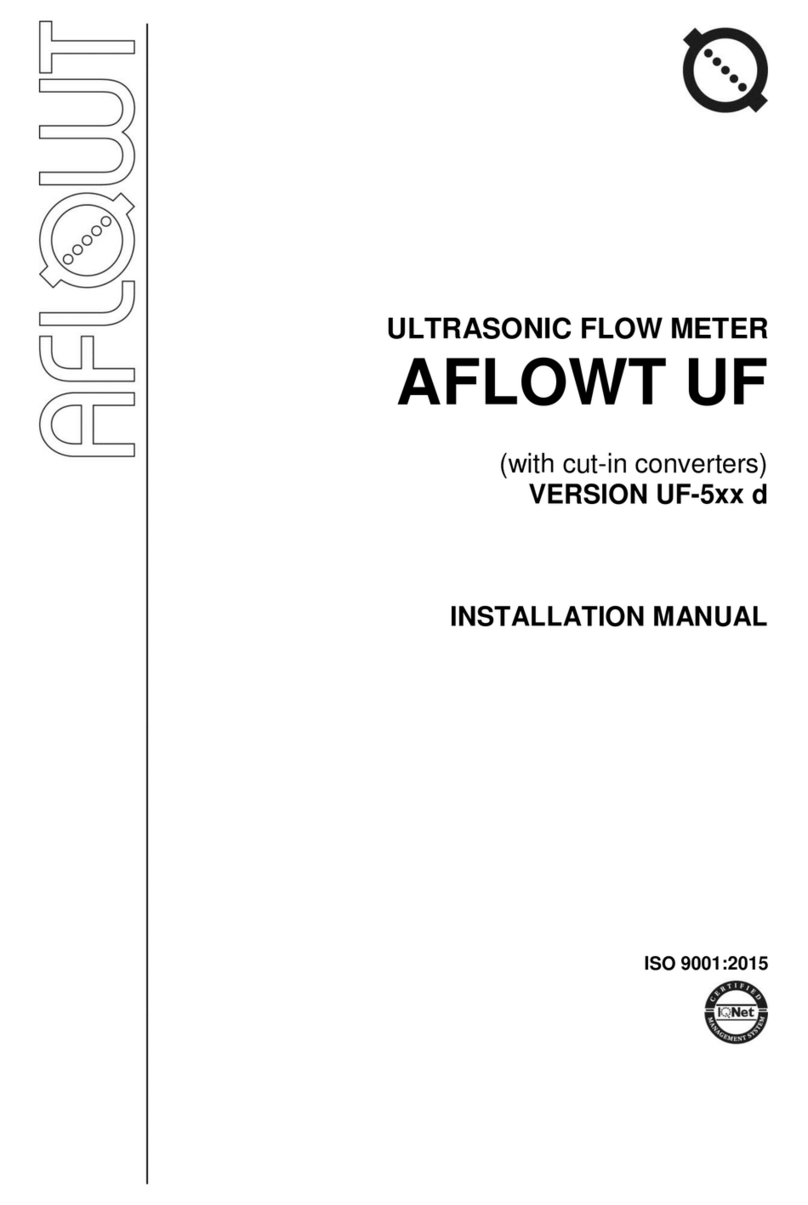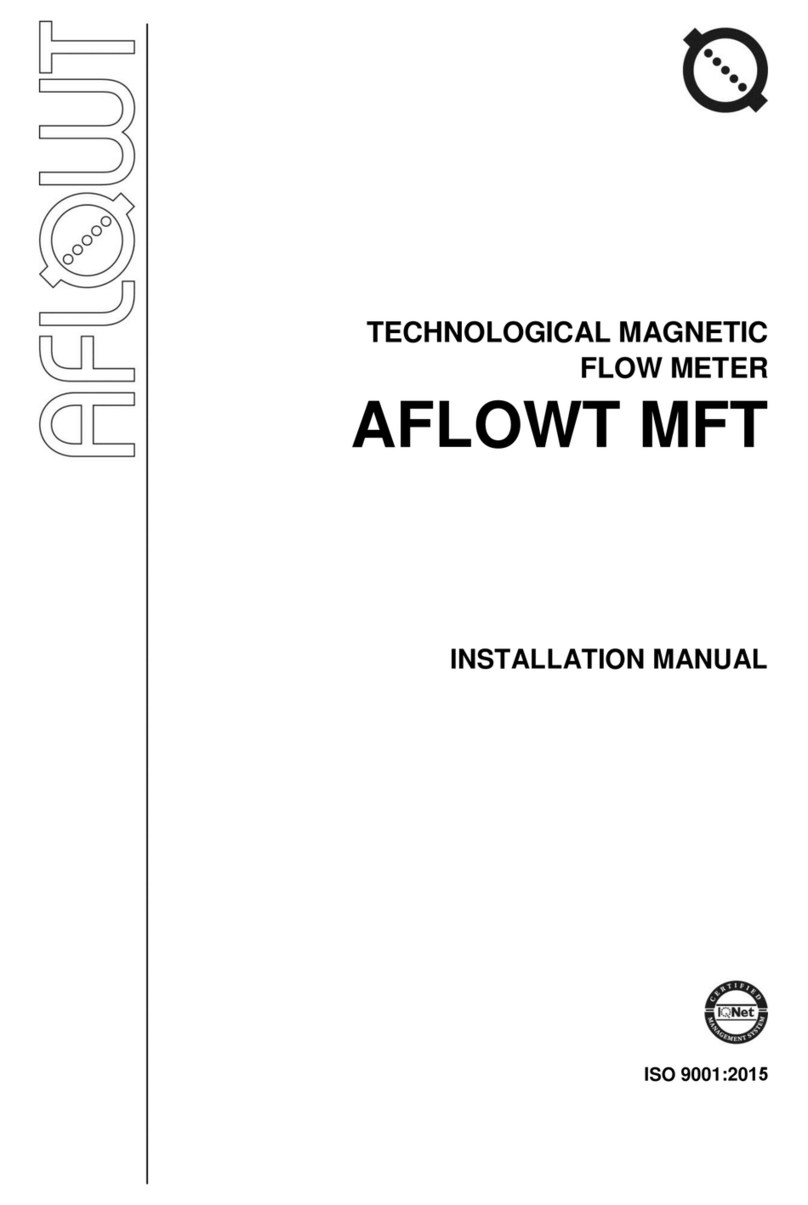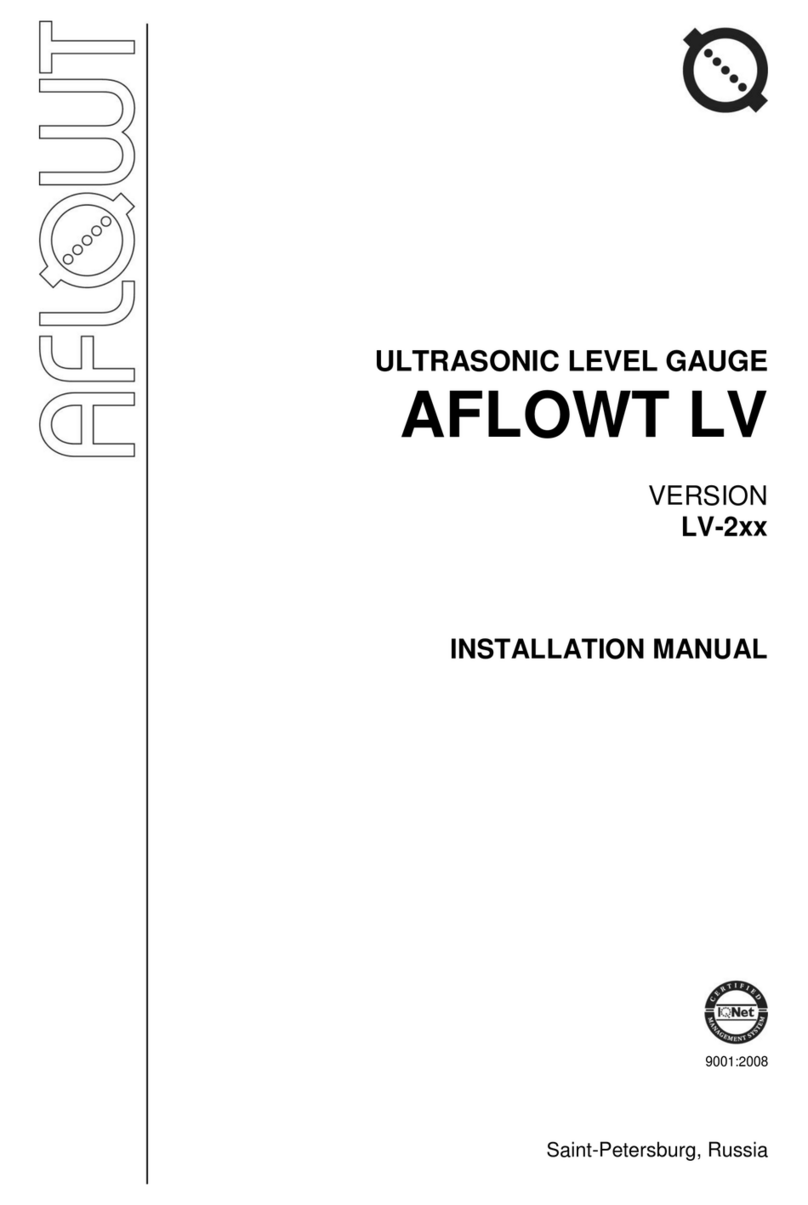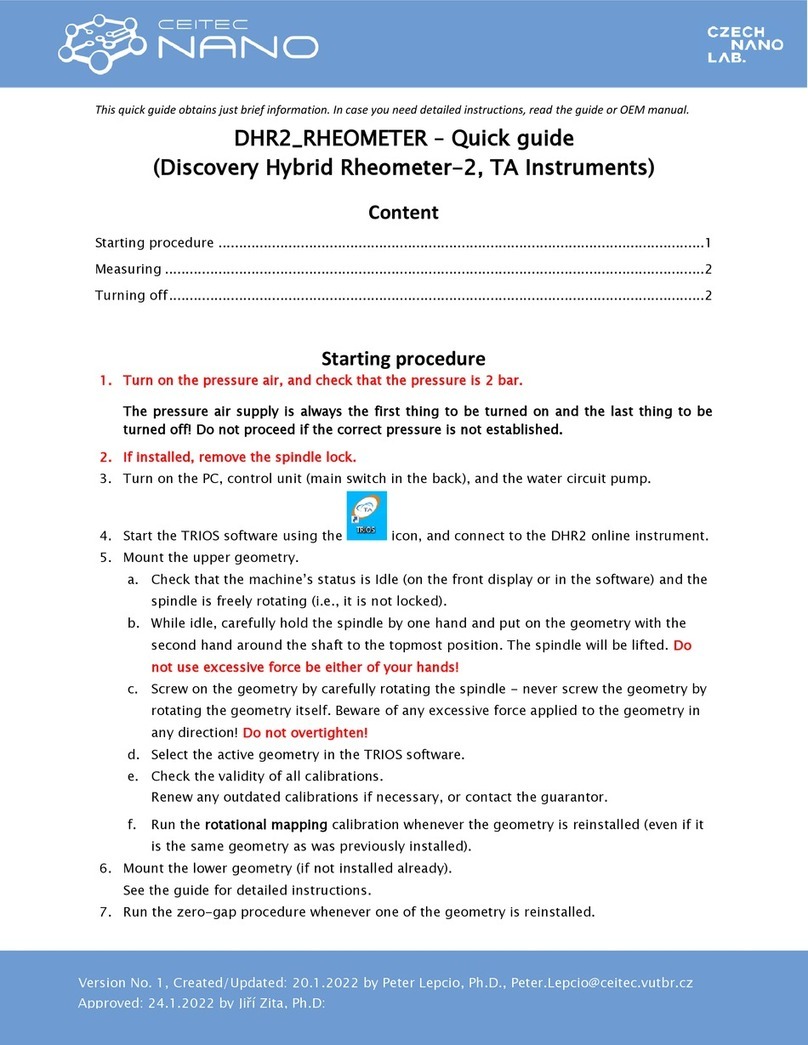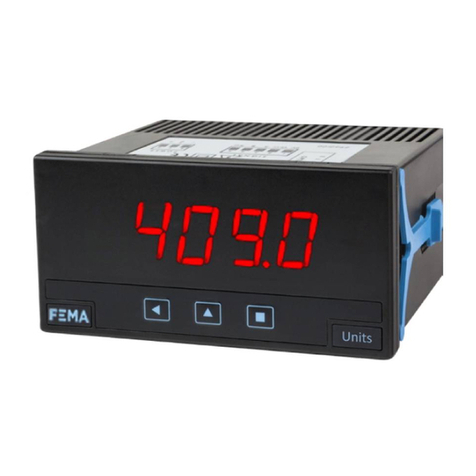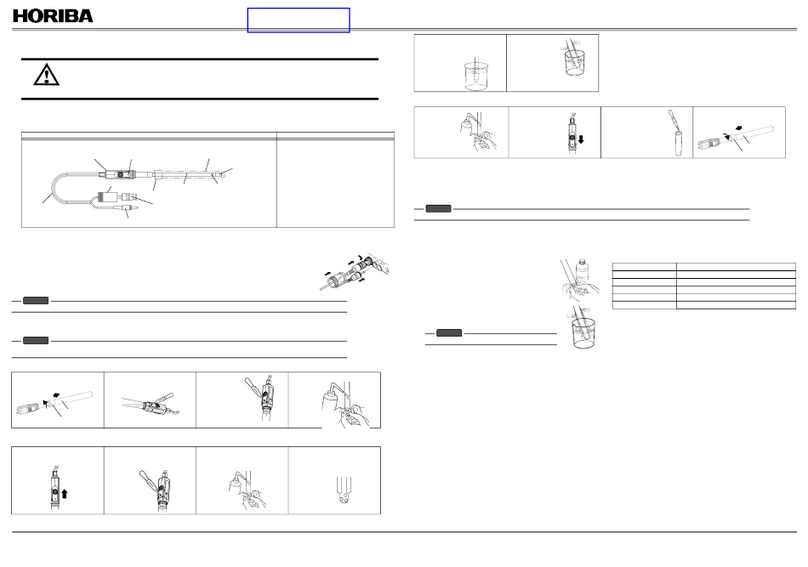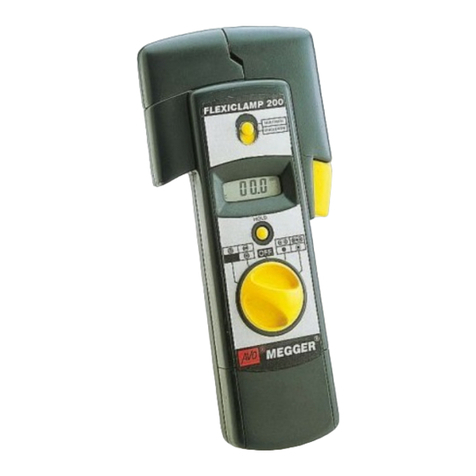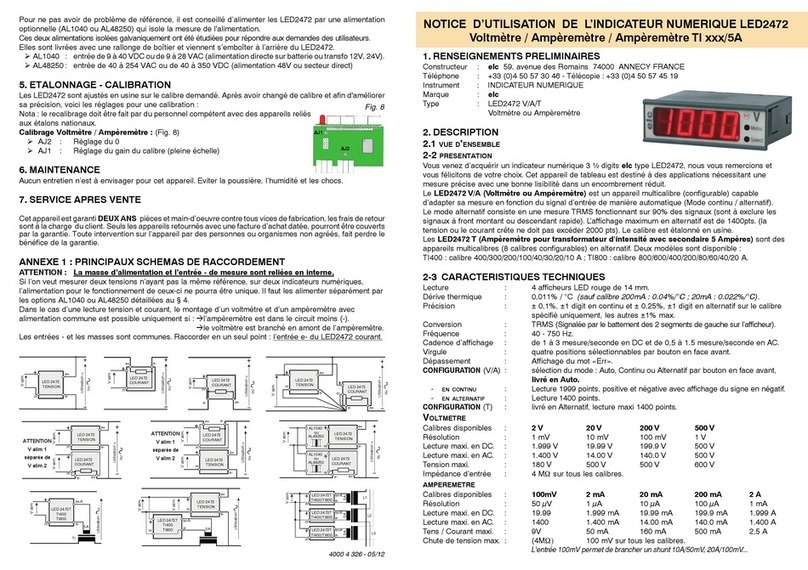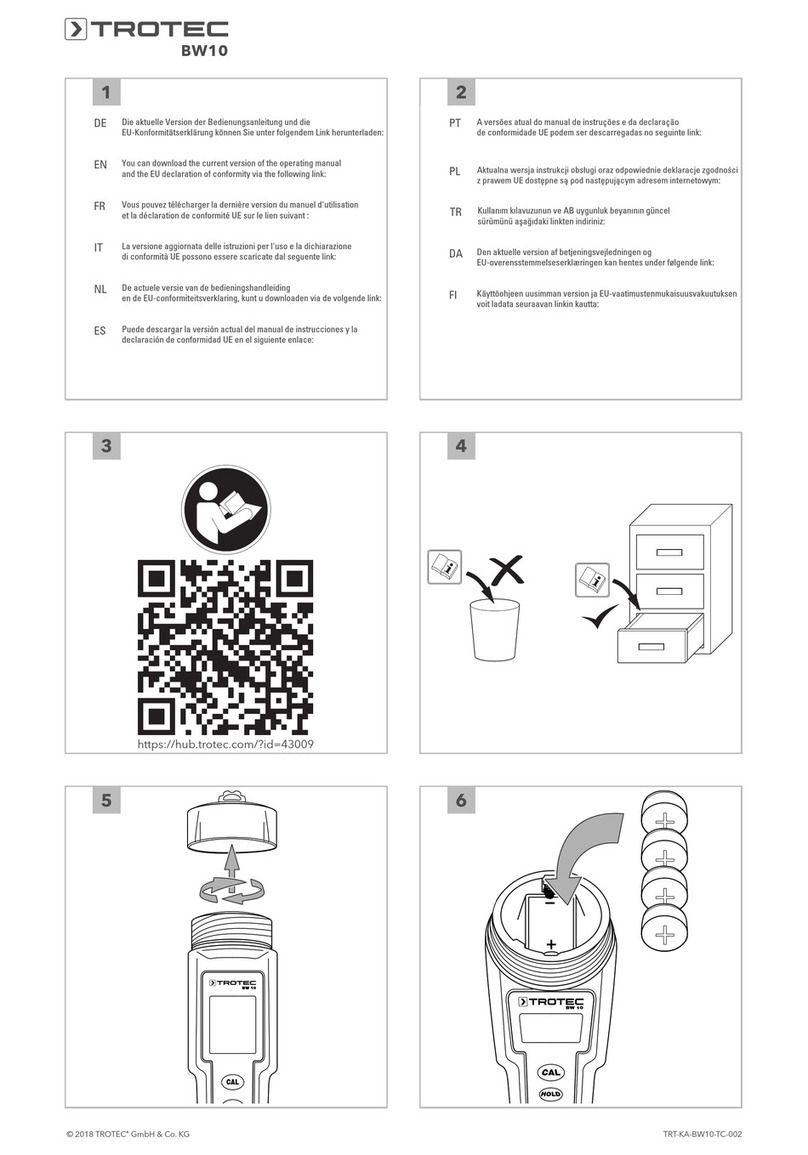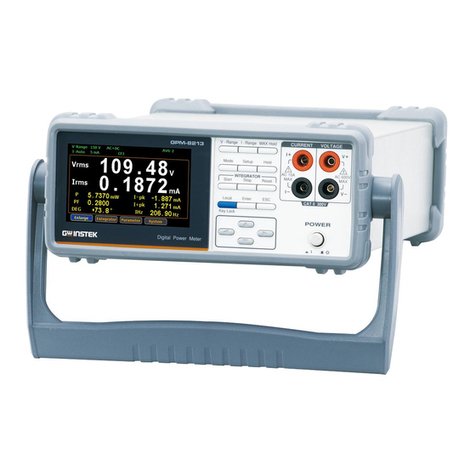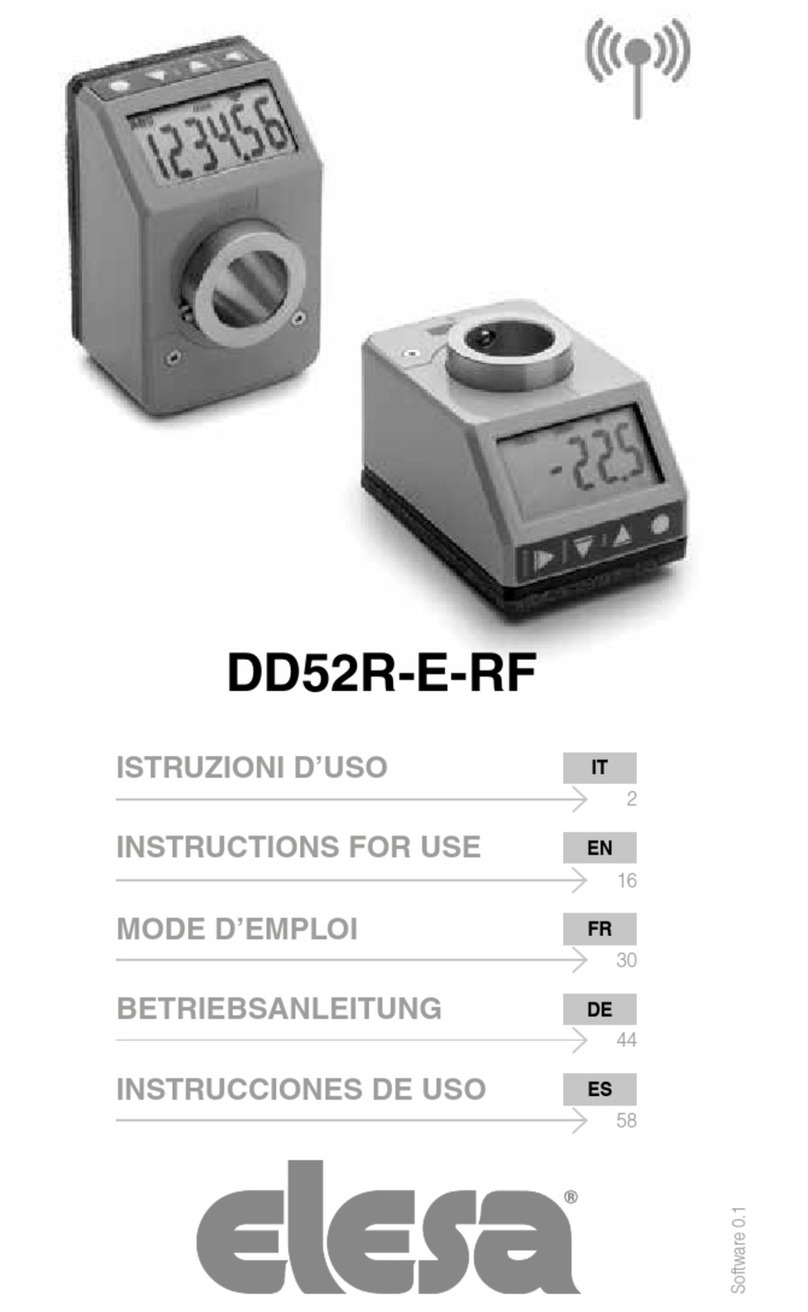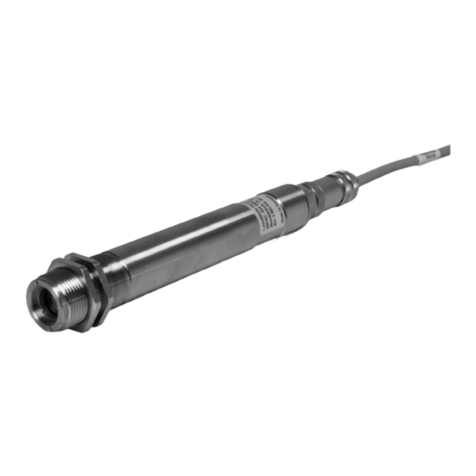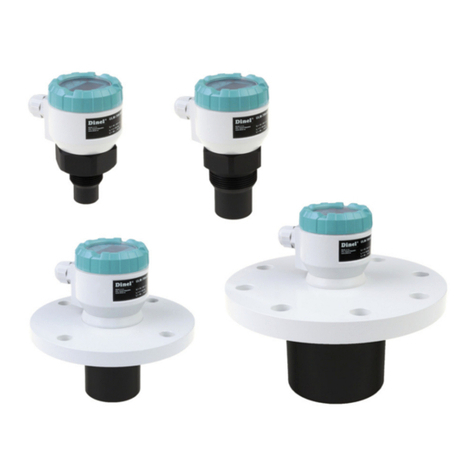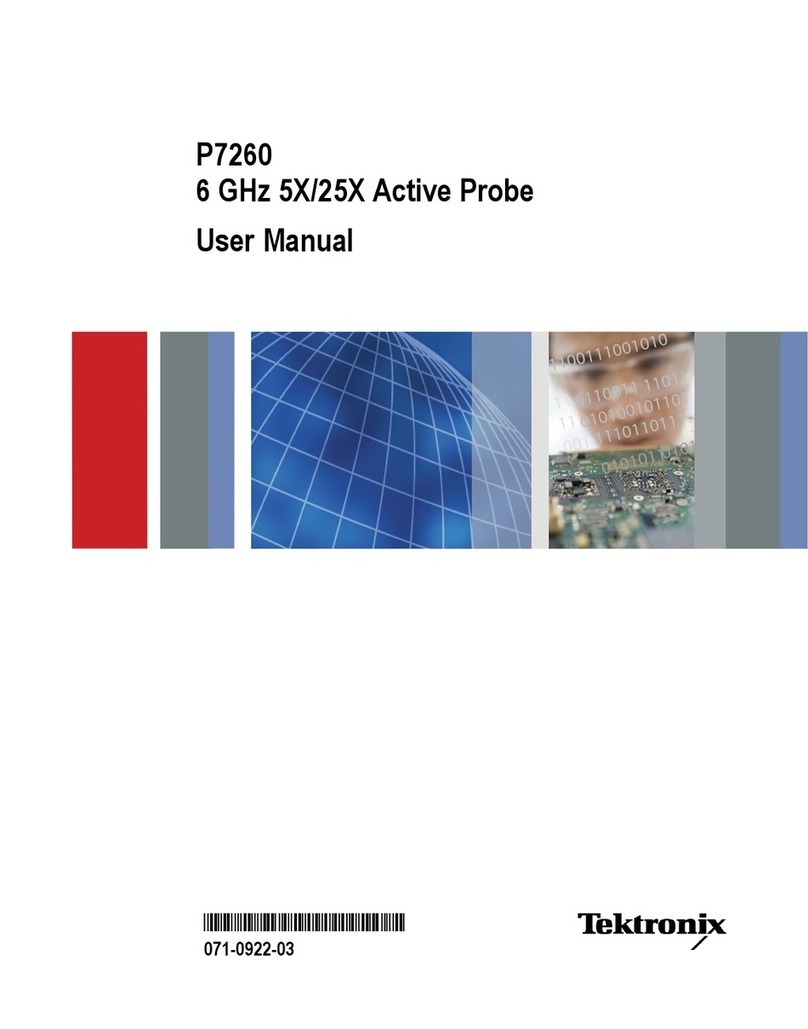AFLOWT MF Pro M Series User manual

ELECTROMAGNETIC
FLOW METER
AFLOWT MF
Version “Pro-×××M×”
INSTALLATION MANUAL
ISO 9001:2015

2
* * *
Manufacturer quality management system is certified to
ISO 9001:2015
* * *
URL: http://www.aflowt.com

3
TABLE OF CONTENTS
INTRODUCTION.....................................................................................................3
1. SAFETY INSTRUCTIONS ..................................................................................5
2. MOUNTING PREPARATION..............................................................................5
3. MOUNTING.........................................................................................................6
3.1. General Requirements...........................................................................6
3.2. Mounting the Flow Meter into the Pipeline.............................................6
3.3. Wiring the Flow Meter..........................................................................12
4. DISMOUNTING.................................................................................................14
5. PUTTING INTO OPERATION...........................................................................15
APPENDIX А. Carbon steel structures for mounting flow meters
into the pipeline…… ..............................................................................................16
APPENDIX B. Holder to Fix Metal Sleeves for Power
and Communication Cables..................................................................................25

4
The present manual covers procedures for on-site mounting and
dismounting of AFLOWT MF electromagnetic flow meters, Pro-×××М×
version, Pro-112MI, -122MI, -212MI, -222MI, -111MA,-121MA, -211MA,
-221MA, -112MC, -122MC, -212MC, -222MC models. In the course of
work, also refer to the "AFLOWT MF electromagnetic flow meter.
Version Pro-×××М×. Operation manual" document.
LIST OF ABBREVIATIONS
DN
MB
MF
- Nominal Diameter
- Measuring Block
- Electromagnetic Flowmeter
CAUTION!
1. Flow meter can be mounted into metal hot fluid pipeline only if mount
components of the pipeline allow for pipeline expansion to prevent
deformation of the flow meter flow pipe.
2. DO NOT touch electrodes in the flow pipe inner channel at any time
when working with the electromagnetic flow meter.
3. When the flow meter is energized, DO NOT perform electric welding in
the room if pipeline where the flow meter is installed is not filled with
liquid, and on the pipeline where the flow meter is installed.
4. While welding, passing of weld current through the flow meter case is
STRICTLY FORBIDDEN.
5. While welding, DO NOT use the flow meter as an installation tool. Install
the flow pipe dimension simulator provided in the delivery package.
6. When mounting and using the flow meter, DO NOT remove protection
rings from the flow pipe. Protection rings are installed to protect
projecting fluoroplastic lining.
7. DO NOT rotate the flow meter mounted in the pipeline around the
pipeline axis.
8. If flow pipe is covered with fluoroplastic and protection rings are
removed, DO NOT remove the tightening stud (bolt) and clamping
plates from the flow meter for more than 10 minutes. The clamping
plates shall be removed right before mounting the flow meter into the
pipeline.
9. When moving, DO NOT lift the flow meter by its measuring block.

5
1. SAFETY INSTRUCTIONS
1.1. The flow meter should be mounted (dismounted) by technicians:
- Certified for performing work of this type
- Having the right to work with electrical installations up to 1000 V
- Familiar with all the instructions outlined for the flow meter and auxiliary
equipment used for mounting and dismounting.
1.2. When working with the flow meter, the dangerous factors are as follows:
- AC voltage (RMS value up to 264 V, frequency 50/60 Hz)
- Pipeline pressure (up to 2.5 MPa)
- Medium temperature (up to 150С).
1.3. In the course of mounting (dismounting) DO NOT:
- Connect to the MF, switch over modes or replace electronic
components when the flow meter is powered up
- Remove the MF from the pipeline until pressure in the pipeline section
worked on is fully released
- Use electronic devices and electric tools them without proper
grounding, and also use the listed devices in a faulty condition.
1.4. Prior to performing work, make sure with use of the appropriate
equipment that no dangerous AC/DC voltage that may cause injury or
death is applied to pipeline section to be worked on.
2. MOUNTING PREPARATION
2.1. The MF should be transported packed in the manufacturer’s box.
2.2. After the MF has been moved to the mounting location from a cold
environment into a warm one (with ambient temperature above zero), it
shall be left in the manufacturer’s box for at least 3 hours to make sure
that no moisture will condensate inside.
2.3. When unpacking, check that the delivery package contains all items
specified in the Equipment Certificate.

6
3. MOUNTING
3.1. General Requirements
When mounting the MF on site, a free pipeline section should be
provided. It is used to mount the flow meter and straight pipe runs of
appropriate length upstream and downstream the flow pipe.
Overall dimensions and weight of the MF are given in Appendix A
of the Operation Manual.
CAUTION! You must choose a mounting location for MF so
that the conditions meet the requirements specified in the
Operation Manual.
3.2. Mounting the Flow Meter into the Pipeline
3.2.1. Mounting considerations:
- The MF may be mounted into horizontal, vertical, or sloping pipeline
without need of dirt traps or special filters
- To prevent air accumulation at the mounting location, the MF should not
be placed at the upper point of the pipeline or in the open-ended
pipeline; the best place to mount the MF (if applicable) is the lower or
the uprising pipeline run (see Fig.1)
- The liquid pressure in the pipeline shall be chosen so that to prevent
gas development
- The MF should be mounted in the pipeline where liquid pulsation and
turbulence are minimal.
MF
Fig.1. Recommended MF locations.

7
- Straight pipe runs with nominal diameter (DN) equal to nominal
diameter of the MF should be provided upstream and downstream the
MF. Length of the runs should not be less than specified in Table 1.
The runs must not include devices or components that may disturb flow
structure
- When the MF is operated, the flow pipe inner channel should be fully
filled with liquid
- When mounting the MF into horizontal or oblique pipeline, position the
axis of the measuring block (MB) stand in vertical plane going through
the pipeline axis. Maximum deflection is ±30°
- Intensity of external magnetic field (commercial frequency) should not
exceed 400 A/m.
Table1. Length of straight pipe runs
Unidirectional flow
Bidirectional flow
upstream MF
downstream MF
upstream MF
downstream MF
5DN
2DN
5DN
3DN
3.2.2. The assembly-welded structure can be used to mount the flow meter
into the metal pipeline. The structure is assembled from fittings and
included in the delivery package.
Fittings provided on request can be used to mount the flow meter
into the plastic (metal-plastic) pipeline.
3.2.3. Fitting assembly to mount into the metal pipeline.
3.2.3.1. A fitting assembly for the assembly-welded structure includes:
- Flat weld flanges (modified)
- Flow pipe dimension simulator of appropriate size and design (flanged
or wafer type)
- Gaskets
- Fasteners.
The simulator overall mounting dimensions and DN correspond to
the dimensions of the flow meter flow pipe to be mounted with this
fitting assembly. The simulator is installed instead of the MF when
performing mounting or welding or dispatching the MF for regular
verification or repair.
In addition, the assembly may include straight pipe runs of
appropriate length (DNs equal to DN of the MF) and concentric
adaptors to provide connection from pipeline greater DN1 (DN2) to the
lesser DN of the MF.
View of assembly-welded structures made of stainless steel and
fully assembled from all components, reference linear dimensions, and
types of flange modifications are specified in Appendix A.
NOTE. It is prohibited to reduce length of supplied straight pipe
runs to meet requirements for length of straight pipe runs provided in
Table 1.

8
Delivery package is agreed with the customer. Set of design
documentation for the fitting assembly is available at customer's option.
3.2.3.2. Welding of assembly-welded structure components and connection of
the components to the pipeline at flow meter location must be
performed in compliance with applicable regulatory documents.
Alignment of the whole unit and flatness/parallel alignment of the
flanges upstream and downstream the flow meter flow pipe must be
provided.
3.2.3.3. The procedure for manufacturing the assembly-welded structure is as
follows:
a) Weld the flanges to the straight pipe runs (pipeline) considering that the
straight pipe run (pipeline) axis should be perpendicular to the flange
plain adjacent to the flow pipe (see Fig.2).
b) If necessary, weld the adaptors to the opposite ends of the pipe runs
(see Fig.3).
Рис.2 Рис.3
Fig.2 Fig.3
CAUTION! Overlaps and undercuts inside the channel are
unacceptable. After completing the work, remove burrs and scales from
the inside.
c) Assemble the whole structure fixing components with bolts (studs), see
Appendix A. Please make sure that the simulator is installed into the
assembly-welded structure instead of the flow meter to provide
alignment between two welded units, to ensure flatness/parallel
alignment of the flanges adjacent to the flow pipe and to avoid
damages of the MF during welding of the structure to the pipeline.
During assembling make sure that mounting gaskets included in the
fitting assembly are installed, all assembling bolts (studs) are used and
all nuts are tightened according to Clause 3.2.8.4 of this Manual.
While assembling, please pay attention to the alignment of
threaded holes M5 on cylindrical surface of the flanges adjacent to the
flow pipe. Holes used to connect wires to the MF case must be located
in line that is parallel to the structure axis and allow easy connection of
the wires.
3.2.4. Fitting assembly to mount into the plastic (plastic-metal) pipeline.
3.2.4.1. The fitting assembly for the assembly structure includes:
- Two straight adaptors of appropriate length with DN equal to the flow
meter DN. Flat flange (modified) is welded to one of the adaptor ends.

9
The other (free) end of the adaptor is threaded with straight pipe outer
thread
- Flow pipe dimension simulator of appropriate size and design (wafer
type)
- Gaskets
- Fasteners.
3.2.4.2. The simulator overall mounting dimensions and DN correspond to the
dimensions of the flow meter flow pipe to be mounted with this fitting
assembly.
Assembly view, reference linear dimensions, and types of flange
modifications are specified in Appendix А.
3.2. 4.3. The procedure for assembling fitting assembly is as follows:
a) Put mounting gaskets included in the fitting assembly into adaptor
flanges.
b) Place simulator between adaptor flanges and assemble the whole
structure fixing components with studs. During assembling use all studs
and tighten nuts according to Clause 3.2.7.4 of this Manual.
While assembling, please pay attention to the alignment of
threaded holes M5 on cylindrical surface of the flanges adjacent to the
flow pipe. Holes used to connect wires to the MF case must be located
in line that is parallel to the structure axis.
3.2.5. Mounting fitting assembly into the metal pipeline.
3.2.5.1. Before mounting an assembly (assembly-welded structure), fix the
pipes that may tip out of their axes after cutting the pipeline to
stationary supports by clamps. Drain liquid from the pipeline, cut it and
mount the fitting assembly considering the following conditions:
- The longer straight pipe run should be the first upstream
- Threaded holes M5 on cylindrical surface of the flanges used to
connect wires to the MF case should be in position allowing easy
connection of the wires.
3.2.5.2. When welding the fitting assembly to the pipeline, the inside of the
assembly and pipeline should be protected from burrs and scales.
After welding the weld joints must be stress relieved by means of
heat treatment.
3.2.5.3. After completion of work, check weld joints and matting faces for
leakages according to current norms specified for pipelines of this type.
Re-weld bad joints and replace gaskets, if necessary.
Wash the system before the simulator is replaced by the flow
meter.
The fitting assembly should not be subjected to stresses and
strains from the pipeline (bending, compression, tension, twisting
caused by disbalance, misalignment or torque nonuniformity). To
prevent this, leave supports of the inlet and outlet ducts and tighten
fastening clamps.

10
3.2.6. Mounting fitting assembly into the plastic (metal-plastic) pipeline.
3.2.6.1. Before mounting drain liquid from the pipeline and cut the pipeline
where the flow meter will be installed. Fix the assembly to stationary
supports by clamps where pipeline is cut considering the following
condition: threaded holes M5 on cylindrical surface of the flanges used
to connect wires to the MF case should be in position allowing easy
connection of the wires.
3.2.6.2. Connect pipeline ends to the fitting assembly using fittings of
appropriate typical size which are installed on plastic (metal-plastic)
pipelines.
An adaptor coupling may be used as confusors/diffusors if a
different diameter of the pipe is necessary.
3.2.6.3. After completion of work put the pipeline into operation to check joints
and connections for leakages according to current norms specified for
pipelines of this type.
Wash the system before the simulator is replaced by the flow
meter.
3.2.7. Mounting the flow meter into the metal pipeline.
3.2.7.1. Position the flow meter so that the axis of the measuring block stand is
arranged in vertical plane with maximum deflection of 30. The arrow
on the flow pipe shall point to the flow direction.
NOTES.
1. Before mounting the flow meter into the pipeline remove protection rings
from the flow pipe lining if liquid under control is aggressive towards the
material of protection rings.
2. The flow meter for measuring bidirectional flow may be installed without
regard to the pipeline flow direction.
3.2.7.2. The non-flanged flow meters of Pro-×1×М× versions with protection
rings are automatically centered relative to companion flanges of the
pipeline since outer diameter of external rings matches the diameter of
flange grooves.
When mounting the MF, put new gaskets provided in the delivery
package into the companion flanges.
To move pipeline flanges apart when installing or removing the MF
(simulator), it is recommended to use a special extension tool.
3.2.7.3. When installing flow meters of Pro-×2×М× versions (flanged flow
meters), put bolts into mating flanges of the flow pipe from the side of
the pipeline flanges. Length of the bolts must provide the distance of
minimum 3 mm from a bolt end to the flow meter assembly.
Alignment of the pipeline and flow pipe inner channel is provided
when flow meter flanges are aligned with pipeline companion flanges.
When the simulator is replaced by the flow meter, put additional
gaskets included in the delivery package to provide leak tightness of
joints between flow meter flanges and pipeline mating flanges (if
necessary).

11
CAUTION! Please make sure that gaskets are aligned relative to
the flow pipe inner channel, i.e. a gasket must not even partly cover the
inner channel. To provide gasket alignment, it is recommended to fix
the gaskets by adhesive.
The flow meter shall be mounted into the pipeline when all
construction, welding and other works are finished.
3.2.7.4. When mounting the MF (simulator) into the pipeline tighten nuts in order
specified in Fig.4, using a torque indicating wrench with maximum
torque value as per Table 2. Exceeding torque value may cause
damage to the flow pipe resulted in leaking of liquid into the inner
cavity of the MF.
To prevent disbalance and misalignment, it is recommended to
tighten nuts in several steps increasing torque step-by-step up to the
value specified in Table 2 while controlling alignment of the mating
flanges.
Table 2
DN, mm
10
15
20
25
32
40
50
65
80
100
150
200
300
Torque, N⋅m
15
15
15
20
25
35
35
40
50
60
80
100
150
Fig.4. Order of tightening flange nuts
DO NOT rotate the MF mounted in the pipeline around the
pipeline axis.
3.2.8. A flow meter is mounted into the plastic (metal-spastic) pipeline the
same way as a construct flow meter of wafer type is mounted into the
metal pipeline.
CAUTION! Follow recommendations of pipe manufacturers when
mounting into plastic (metal-plastic) pipelines.

12
3.3. Wiring the Flow Meter
3.3.1. Power and communication cables are connected to the MF after it is
installed into the pipeline. Cables are passed via corresponding MB
through connections and connected to boards of processor and
communication modules. Schematics of the input and outputs are given
in Appendix B of the Operation Manual.
The MF power supply cables should be connected considering the
operating conditions. As a power cable, you may use any 24 V two-wire
circular section cable with the cross section of at least 0.5 mm2. Cable
length for one MF is up to 500 m.
It is permissible to power several flow meters from one secondary
power source only if there is no difference in potential between
pipelines where flow meters are installed. In this case, permissible
cable length is reduced proportionally.
As a communication cable for a serial interface output and general-
purpose outputs, you can use any two/four-wire circular section cable
with the cross section of at least 0.35 mm2and length of up to 300 m.
Use four-wire cable for simultaneous connection of both general-
purpose outputs.
A cable for the current output is selected considering load rating of
the output as well as the parameters of an input connected to receive
the current signal.
Power and communication cables used shall comply with the flow
meter operating conditions.
3.3.2. Prior to connection, cut isolation from cable ends by 5 mm and solder
them. Attach the socket (cable) connector provided in the delivery
package to the power cable considering polarity, then attach the socket
connector to the plug on the processor module board. Cables for the
control input and general-purpose outputs are directly connected to the
terminals on the communication module board.
The power cable is passed through one cringle next to the sticker
24 V; the communication cable —through the other cringle.
CAUTION! To ensure appropriate protection of IP65 flow
meter, wiring shall be performed according to the following
requirements:
- When mounting the flow meter into a sloping or vertical pipeline install
measuring block with through connections downwards
- Use circular section cables with outer diameter of 6.0–9.5 mm as power
and communication cables
- Seals of the measuring block case should be clean, undamaged and
placed in corresponding grooves without waves and loops
- Plugs shall be installed into unused through connections
- MB cover screws and through connection nuts shall be properly
tightened after wiring.

13
To prevent measuring block from moisture ingress via through
connections when using flat section cables it is necessary to
connect cables so that falling U-loop is formed in the vertical
plane (see Fig.5).
a) horizontal b) sloping c) vertical
Fig.5. Position of cables at the inlet of through connections when
mounting MF into the pipeline
3.3.3. Communication cables and a network cable are fixed on the wall if
possible. To avoid mechanical damages, it is recommended to place
them in a metal tube or sleeve. Communication and power cables may
be placed in the same tube (sleeve).
You may use a holder (see Appendix B) to fix metal sleeves with
power and communication cables to the MB.
DO NOT fix the cables to the pipeline with heat-carrying
medium.
3.3.4. To provide electrical contact, it is necessary to connect sections of the
pipeline that was cut in the MF mounting location by wires via a terminal
located on the MB. Wire cross section should be at least 4 mm2. If the
pipeline has cathode protection, cross section of the wires shall
correspond to the value of cathode protection current.
Use threaded holes M5 on cylindrical surface of the flanges to
connect the jumpers.
3.3.5. The need in protective grounding of the device is determined based on
power supply value and environment conditions.
To avoid device failure do not use a lightning protection system as
protective grounding.
The grounding conductor (mechanically protected copper wire)
cross-section must be at least 2.5 mm2and at least 4 mm2if the
grounding conductor has no mechanical protection.
The grounding conductor is connected to the MB fixing screw.
Wires for connection to the pipeline flanges are also connected to this
screw.
CAUTION! If the pipeline is equipped with cathode protection,
do not ground the flow meter.

14
4. DISMOUNTING
4.1. The order of dismounting the flow meter before dispatching for regular
calibration or repair is as follows:
- Turn off power, then disconnect network and signal cables from the flow
meter
- Disconnect wires from the pipeline flanges
- Cut off liquid at the FS location, make sure that pressure is released
and drain the liquid
- Dismount the flow meter and install the simulator
- Immediately after the MF covered by fluoroplastic without
protection rings is dismounted from the pipeline, install protection
rings or clamping plates with a tightening stud (bolt) on the MF.
4.2. After simulator installation check mating surfaces for leakage. Replace
gaskets, if necessary. In case that no leakages are found, put the
pipeline into operation.
4.3. Remove sediment and liquid residues from the inner channel of the flow
meter flow pipe before packing.

15
5. PUTTING INTO OPERATION
5.1. When putting the flow meter into operation check the following:
- The flow is in the direction of the arrow on the flow meter case
- Lengths of the inlet and outlet straight pipe runs of the MF are relevant
to the flow reversibility
- The flow meter and related equipment are connected in accordance
with the selected wiring diagram
- Flow meter outputs operate in the preset modes
- Power supply voltage corresponds to specifications.
5.2. At first power-up or after a long break in operation, the flow meter
becomes operational after:
- It is washed by medium for 30 minutes
- It is kept powered for 30 minutes.
5.3. To prevent changing of service parameters after putting the device into
operation, you can seal terminal pairs that allow to change these
parameters on the communication module board.
To protect the device from unauthorized access during operation
two fixing screws of the measuring block case cover can be sealed.
If a bypass is installed, it is necessary to seal its gates in closed
position.

16
APPENDIX А. Carbon steel structures for mounting flow meters
into the pipeline
Flow direction
Dy1
Dy2
13
23 124 5
L1
L3
L4
LL2
1 —taper adaptor; 2 —straight pipe run; 3 —mating flange; 4 —MF
(flow pipe dimension simulator); 5 —wires connecting MF case and
pipeline.
Fig.А.1. Assembly-welded structure for mounting flow meters of Pro-×12М×
versions (lined with fluoroplastic) with protection rings (wafer
type) into the pipeline
Table А.1. Dimensions of the assembly-welded structure for MFs of Pro-
×12М× versions with protection rings (mm)
DN
DN1, DN2
L*
L1*
L2*
L3*
L4*
Notes
10
20
93
78
78
249
307
25
367
**
32
337
40
367
**
50
397
**
65
447
**
15
20
93
103
78
274
332
25
392
**
32
362
40
392
**
50
422
**
65
472
**
20
25
114
127
87
328
385
32
385
40
385
50
415
65
555
**
80
565
**

17
Table А.1 (continued)
DN
DN1, DN2
L*
L1*
L2*
L3*
L4*
Notes
25
32
114
152
102
368
425
40
425
50
455
65
595
**
80
605
**
100
615
**
32
40
124
187
122
433
490
50
520
65
540
80
670
**
100
680
**
40
50
134
232
152
518
675
65
725
80
735
100
865
**
125
905
**
150
855
**
50
65
154
288
188
630
767
80
777
100
787
125
827
150
777
65
80
175
363
233
771
918
100
928
125
968
150
918
200
958
80
100
175
438
278
891
1048
125
1088
150
1148
200
1078
250
1328
**
300
1328
**
350
1588
**
100
125
216
538
338
1092
1288
150
1348
200
1278
250
1368
300
1368
350
1788
**
400
1788
**
150
200
236
794
494
1524
1797
250
1877
300
1797
350
1957
400
1957
500
2557
**
* - reference dimensions without processing tolerances
** - adaptor is made of two concentric adaptors
Note. The total length “L*”, mm, of flow meter, lined with polyure-
thane without protection rings reduced to 8 mm.

18
Flat weld flanges (for 2.5 MPa pressure) are used to mount the MF
into the pipeline:
- For DN10-DN20 —flanges of design type B (with a fixing ridge)
- For DN25–DN150 —flanges of design type F (with a notch)
Modification of flanges is needed before welding which means
drilling a threaded hole M5 on the flange cylindrical surface to fix wires
(Fig.A.2).
DN,
mm
D6,
mm
h2,
mm
a,
mm
db,
mm
Initial flange
10
35
Н12
2,5±0,2
26
10
Flange 20-25-01-1-B St25
15
40
Н12
2,5±0,2
26
15
Flange 20-25-01-1-B St25
20
51
H12
3+0.5
3
33
Flange 25-25-01-1-B St25
1 –revision to F;
2 –threaded hole М5 (revision)
Fig.А.2. Modification of flanges to mount MF DN10-DN20
To weld flanges for MFs with DN10-DN20, shown in Fig.A.2, to the
pipeline, adaptors shall be used (see Fig.A.3) with length of no less
than that of the straight pipe run (see Table 1).
After welding the flange to the adaptor, process the surface
adjacent to the flow meter as shown in Fig.A.4. The adaptors and
pipeline sections are welded butt-to-butt.

19
а) DN10, DN15
b) DN20
DN, mm
d1, mm
d2, mm
d3, mm
c, mm
L, mm
L1, mm
10
11,6
26
17
0,5+0,5
75
40
15
15
26
21
75
40
100
65
20
20
32
-
10,5
84
124
Fig.А.3. View and dimensions of adaptor DN10-DN20

20
Flange
Wetted seam
Transitive a
branch pipe
3± 0.2
6.3
Fig.А.4. Flange DN10-DN20 and pipe adaptor welded together
This manual suits for next models
12
Table of contents
Other AFLOWT Measuring Instrument manuals
Popular Measuring Instrument manuals by other brands

Sokkia
Sokkia SET630R quick start guide
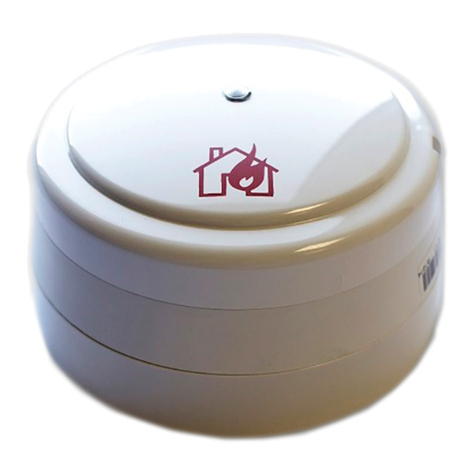
Ziton
Ziton ZR4-RL installation guide
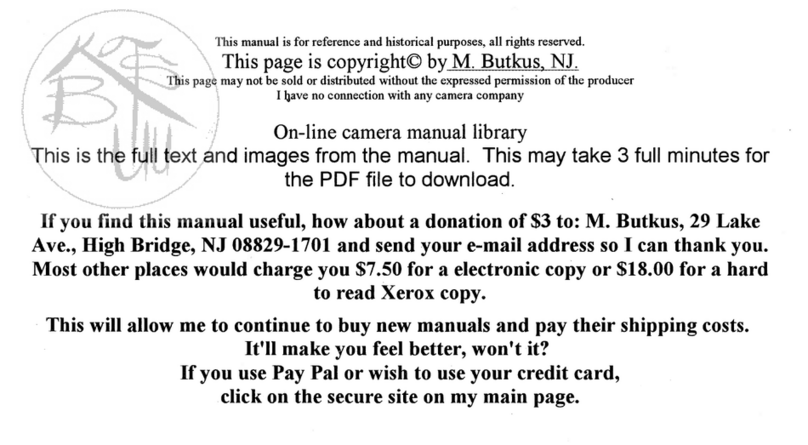
Gossen MetraWatt
Gossen MetraWatt lunasix Operating instructions manual

Heuresis
Heuresis Pb200i Alpha user guide

Thermo Scientific
Thermo Scientific Star Series user guide

LOVATO ELECTRIC
LOVATO ELECTRIC DME D122MID installation manual
